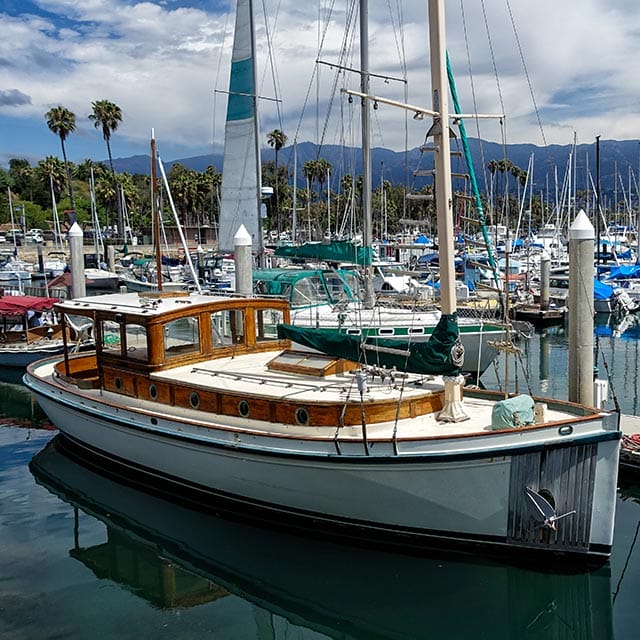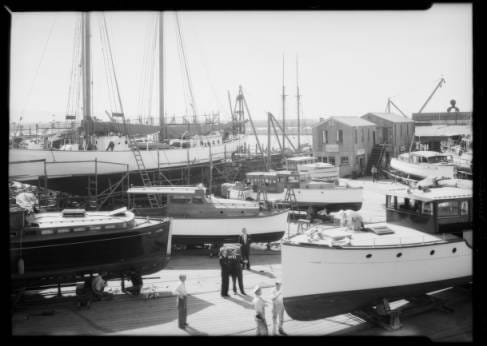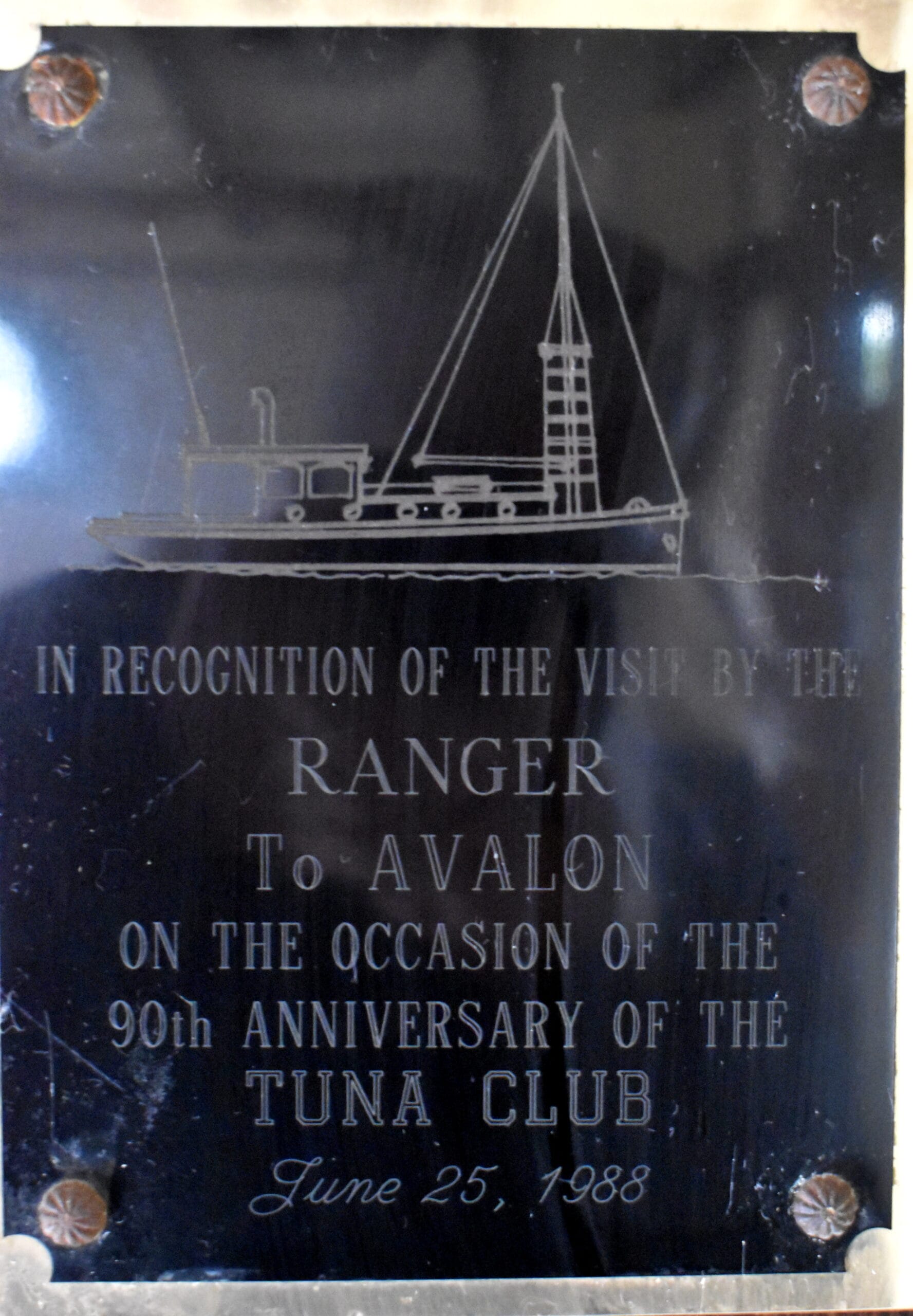Curator’s Tour of the Classic Yacht: Ranger

By Rita Serotkin
You’ve probably seen her at her berth in front of the Santa Barbara Maritime Museum and leading the annual Parade of Lights. Or perhaps you’ve seen her plying the waters of the Channel or serving as a backdrop for advertising and wedding portraits, but what do you really know about Ranger, the classic wooden fishing boat that serves as SBMM’s flagship? We decided to do some research, to find out more about her history and specs, to photograph her, to talk with her crew, and to share what we discovered with our readers and members.
First and foremost, Ranger, is a genuine, classic big-game fishing yacht, the first private fishing yacht built on the West Coast and is the oldest boat in the Harbor. Donated by Jack Morehart, she became the Maritime Museum’s first large exhibit.
Ranger was built at Fellows and Stewart, Inc. in San Pedro, California, a shipyard which was founded in 1896 by Joe Fellows, Victor Stewart, and naval architect Joseph Pugh. Her basic plumb-stemmed fantail design was inspired by boats used by the US Forest Service Rangers to patrol the Chugash and Tongass National Forests (and now you know the inspiration for her name!).
Built and launched in 1917, she was made to the specifications of Jimmy Jump, Commodore of the Catalina Island Tuna Club, and may be one of only three Fellows and Stewart yachts built during its first 20 years that is still afloat. Other classic yachts built by the yard include Rudolph Valentino’s yacht Charade (Valentino was also a member of the Tuna Club) and Stan Laurel’s Ida May, both built in 1926.

For many years, Ranger served as the flagship of the Catalina Island Tuna Club. The Tuna Club was formed by a group of sportfishing enthusiasts to establish a competition based on the size and variety of fish caught on various strengths of line and type of lure. Twenty-six trophy-winning fish were caught from Ranger; two of these light tackle records still stand: the largest tuna and the largest broad bill swordfish. Over the years, celebrities such as Humphrey Bogart, Zane Grey, John Wayne, and Errol Flynn fished from Ranger and, more recently, the vessel has been used for photo-shoots by Lands’ End and Kevin Costner.
In the early 1930s, Ranger was shipped to Hawaii via commercial steamship where she fished the waters for three years with great success. While in Hawaii, her interior living area was paneled in the beautiful Koa wood she still displays today. Ranger has a full galley, and her living area is composed of four bunks with a table for four between the two aft bunks. Kerosene lanterns provided the original interior lighting; today she uses a 12-volt electric system, but she still has the original anchor winch and her 1917 kerosene running lights.
The comfortable cockpit originally featured two swivel fighting chairs with rod sockets. One of these chairs now sits in the Maritime Museum’s Ranger Exhibit, while the other is part of the Museum’s interactive Sportfishing Exhibit.
Ranger’s length is 46 feet, her overall beam (width) is 12 feet; her draft is 4 feet, 5 inches; and she has a displacement of 35,000 pounds. The wood mast and boom accommodate a stabilizing sail, which helped the boat to resist the pull of the largest game fish. Because of the high quality of her original design, construction, and materials, she is still seaworthy and continues to take passengers on tours of the Harbor and Channel. Originally built of 2”x 3” steamed oak ribs placed on 12” centers, her original cedar planking was fastened to the oak ribs with iron nails. She was also covered in one-inch teak planks fit over the original fir; but in the 1980s, her then owner Jack Morehart spent 13 years restoring her and had the hull coated with ferro-cement to protect the wooden core. In 1988, Morehart took the newly restored Ranger to Avalon for the 90th anniversary of the Tuna Club; and in 1997, he donated the boat to the Santa Barbara Maritime Museum.

Ranger was first powered by a 30-horsepower, 600-rpm gasoline engine that was so large it took up a major portion of the galley area. In the 1960s, a 60-horsepower 4-234 Perkins diesel engine was installed, giving her a cruising speed of 8 knots. In 1998, Barry Schuyler, then Chairman of the Museum’s Board of Trustees, donated a brand-new Yanmar diesel engine. Ranger now has a cruising speed of 7 knots and a top speed of 10 knots. According to crew member Tom Elliott, “Ranger is a fun boat to take up and down the coast for a couple of hours and get a good view;” and another crew member, Glen Varcoe, said “The Yanmar turbo diesel hums really sweet. It’s really an honor to be part of the Ranger crew.”
In April 2020, Ranger, which was one of the Classic Yacht Association’s (CYA) original charter members, rejoined the association’s Southern California Fleet, which includes member boats from Santa Barbara to San Diego. CYA is “dedicated to the promotion, preservation, restoration and maintenance of fine, old power-driven craft.”
SBMM and Ranger owe much gratitude to the Moreharts, the Schuylers and Andrew and Mary Jane Cooper, who have been invaluable Ranger supporters.
We hope you will decide to take a closer look at Ranger on your next visit to the Harbor; and come on a Thursday or Saturday morning at 10:00am to meet her crew and volunteer to help with her maintenance and care. There is always a need for volunteers willing to help with mechanical systems, marine plumbing, woodworking, varnishing, and general cleaning–and donations, of course, to help support her expenses and docking fees.

